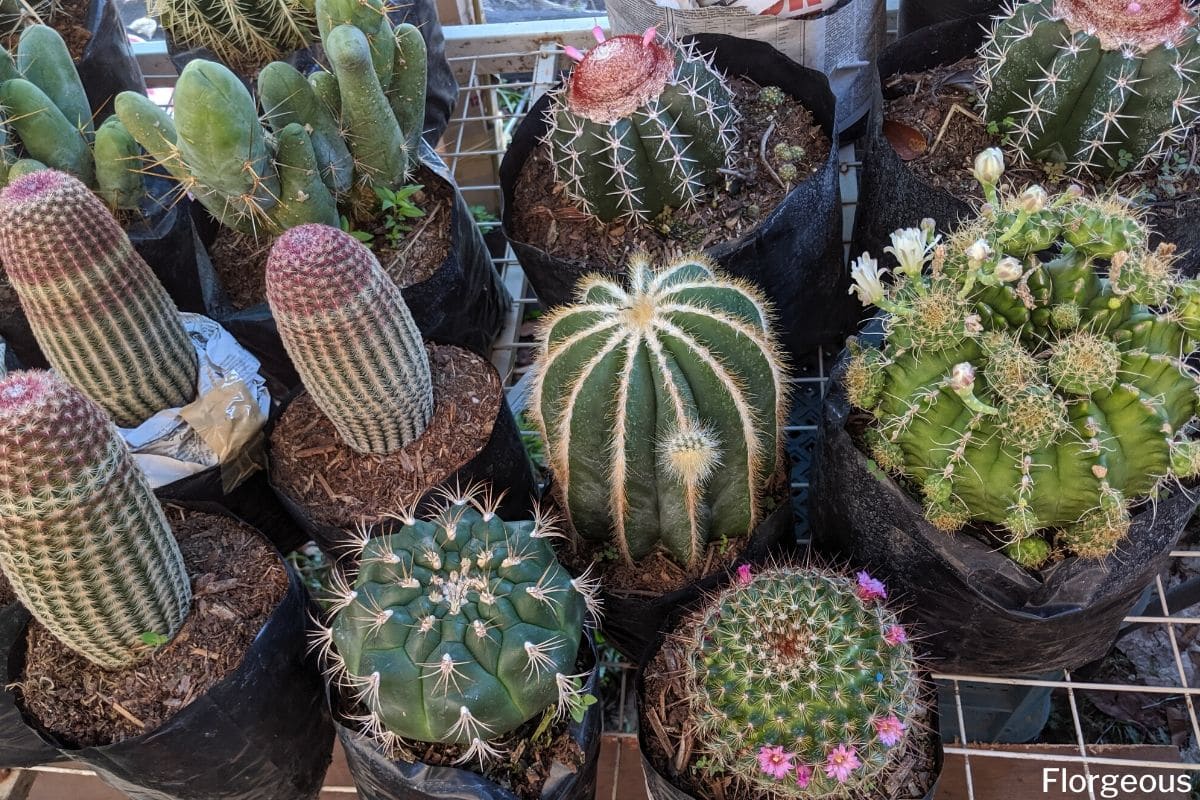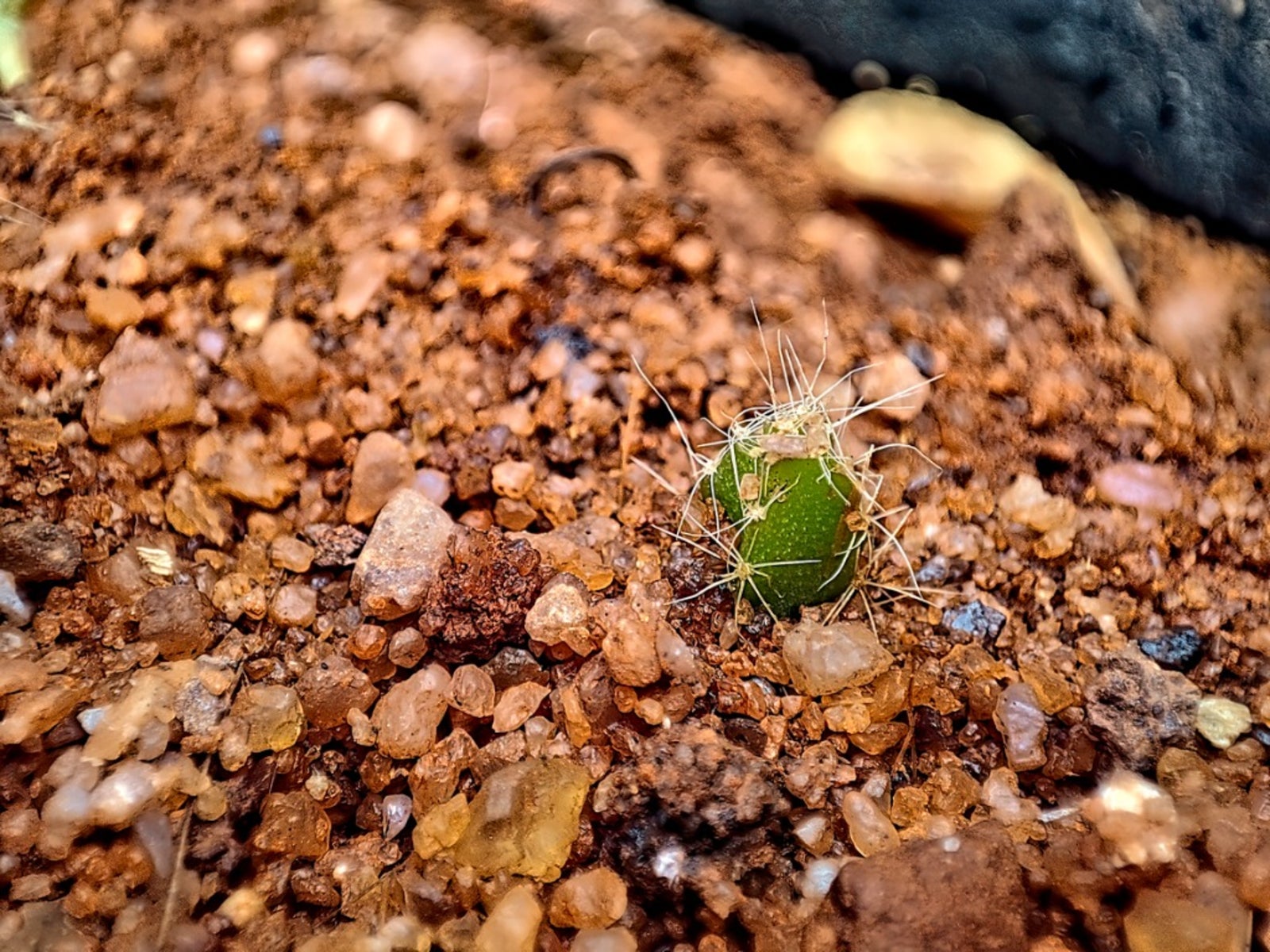Understanding Cactus Seed Germination
Cactus seed germination is a critical stage in the growth of these fascinating plants. To answer the question of what cactus sprouts look like, it’s essential to understand the process of germination. Cactus seeds typically require a period of dormancy, followed by optimal conditions to sprout. The ideal environment for germination includes warm temperatures, high humidity, and adequate light. The average time for cactus seeds to germinate can range from a few days to several weeks, depending on the species and conditions.
For example, the popular Christmas cactus (Schlumbergera bridgesii) can take anywhere from 1-3 weeks to germinate, while the slower-growing saguaro (Carnegiea gigantea) may take 2-6 weeks. Providing the right conditions is crucial for successful germination. A well-draining seed starting mix, consistent moisture, and temperatures between 65-75°F (18-24°C) can help stimulate germination.
It’s also important to note that some cactus species, such as the prickly pear (Opuntia spp.), can produce offsets or “pads” that can be used for propagation. These offsets can be removed and rooted to create new plants, bypassing the need for seed germination. However, for those interested in growing cacti from seed, understanding the germination process is essential for success.
In the next section, we’ll explore the first signs of cactus sprouts and what to expect as they begin to grow.
Recognizing the First Signs of Cactus Sprouts
When trying to determine what cactus sprouts look like, it’s essential to recognize the initial signs of growth. Cactus sprouts typically emerge as small, green, and rounded structures that can be easily mistaken for tiny leaves or stems. At this stage, the sprouts are usually around 1-5 mm in diameter and can be difficult to distinguish from the surrounding soil.
One of the most distinctive features of cactus sprouts is their color. Most species produce sprouts with a bright green or yellowish-green hue, although some may have a reddish or purplish tint. The coloration can vary depending on the specific species, growing conditions, and age of the sprout.
In terms of shape, cactus sprouts can be spherical, oval, or cylindrical, depending on the species. Some sprouts may have a small notch or indentation at the top, which can help distinguish them from other plant growths. As the sprouts grow, they will begin to develop their characteristic spines, which can be soft and flexible at first but will eventually harden and become more pronounced.
It’s worth noting that some cactus species, such as the popular Christmas cactus (Schlumbergera bridgesii), can produce sprouts that are more elongated or segmented. These sprouts may have a more pronounced stem or leaf-like structure, which can make them easier to identify.
To help readers visualize the process, here is a rough illustration of what cactus sprouts might look like:

Please note that this illustration is a rough representation and actual cactus sprouts may vary in appearance depending on the species and growing conditions.
How to Identify Different Types of Cactus Sprouts
When trying to determine what cactus sprouts look like, it’s essential to recognize the various types of sprouts that can emerge. Different cactus species produce distinct types of sprouts, each with unique characteristics and growth patterns. Understanding these differences can help you identify the type of cactus you are growing and provide the necessary care for optimal growth.
For example, the saguaro (Carnegiea gigantea) produces a distinctive type of sprout that is characterized by a single, upright stem with a rounded tip. These sprouts can grow up to 1 inch (2.5 cm) in height and have a bright green color. In contrast, the prickly pear (Opuntia spp.) produces sprouts that are more segmented and have a distinctive “pad-like” shape.
The Christmas cactus (Schlumbergera bridgesii) produces sprouts that are more elongated and have a segmented appearance, with each segment having a small notch at the top. These sprouts can grow up to 2 inches (5 cm) in length and have a bright green color with a reddish tint.
Other types of cactus sprouts may have a more cylindrical or spherical shape, and some may produce multiple stems or branches. Understanding the unique characteristics of each type of sprout can help you identify the type of cactus you are growing and provide the necessary care for optimal growth.
Here are some examples of popular cactus species and their corresponding sprout types:
- Saguaro (Carnegiea gigantea): single, upright stem with a rounded tip
- Prickly Pear (Opuntia spp.): segmented, pad-like shape
- Christmas Cactus (Schlumbergera bridgesii): elongated, segmented appearance with a small notch at the top
- Pincushion Cactus (Mammillaria spp.): small, globular shape with short, fine spines
By recognizing the unique characteristics of each type of cactus sprout, you can provide the necessary care and conditions for optimal growth and development.
The Importance of Providing Optimal Conditions for Cactus Sprouts
When trying to determine what cactus sprouts look like, it’s essential to recognize the importance of providing optimal conditions for their growth. Cactus sprouts require specific conditions to thrive, including lighting, watering, and temperature requirements. Providing the right conditions can help promote healthy growth and development, while neglecting these needs can lead to stunted or deformed growth.
Lighting is one of the most critical factors in cactus sprout growth. Most cacti require bright, indirect light to photosynthesize and grow. Placing cactus sprouts in a sunny windowsill or under grow lights can provide the necessary light for optimal growth. However, direct sunlight can be too intense for young cactus sprouts, so it’s essential to provide some shade or filtering to prevent scorching.
Watering is another crucial aspect of cactus sprout care. Overwatering is a common mistake that can lead to root rot and other problems. Cactus sprouts require infrequent but thorough watering, allowing the soil to dry out completely between waterings. This can help prevent waterlogged soil and promote healthy root growth.
Temperature is also an essential factor in cactus sprout growth. Most cacti prefer daytime temperatures between 65-75°F (18-24°C) and nighttime temperatures around 55-65°F (13-18°C). Avoid placing cactus sprouts near heating or cooling vents, fireplaces, or drafty windows, as this can cause temperature fluctuations that can stress the plant.
Soil quality is also vital for cactus sprout growth. Use a well-draining potting mix specifically designed for cacti and succulents, and avoid using regular potting soil. This can help prevent waterlogged soil and promote healthy root growth.
By providing optimal conditions for cactus sprouts, including lighting, watering, temperature, and soil quality, you can promote healthy growth and development. This can help you achieve the desired outcome when trying to determine what cactus sprouts look like.
Common Mistakes to Avoid When Growing Cactus Sprouts
When trying to determine what cactus sprouts look like, it’s essential to avoid common mistakes that can hinder their growth. Cactus sprouts are delicate and require specific care to thrive. Neglecting their needs or making common mistakes can lead to stunted or deformed growth, or even death.
One of the most common mistakes is overwatering. Cactus sprouts are prone to root rot if the soil is too moist. Check the soil regularly, and only water when it’s dry to the touch. Avoid getting water on the leaves or crown of the plant, as this can cause rot and other problems.
Underwatering is another common mistake. Cactus sprouts need consistent moisture to grow, especially during the first few weeks after germination. Make sure to water them regularly, but avoid overwatering.
Inadequate light exposure is another mistake to avoid. Cactus sprouts need bright, indirect light to photosynthesize and grow. Placing them in a sunny windowsill or under grow lights can provide the necessary light, but avoid direct sunlight, which can cause scorching.
Temperature fluctuations can also harm cactus sprouts. Avoid placing them near heating or cooling vents, fireplaces, or drafty windows, as this can cause temperature fluctuations that can stress the plant.
Using the wrong soil is another mistake to avoid. Cactus sprouts require well-draining soil to prevent waterlogged soil and root rot. Use a potting mix specifically designed for cacti and succulents, and avoid using regular potting soil.
By avoiding these common mistakes, you can promote healthy growth and development in your cactus sprouts. Remember to provide the right conditions, including lighting, watering, and temperature, and avoid neglecting their needs.
How to Transplant Cactus Sprouts for Continued Growth
When trying to determine what cactus sprouts look like, it’s essential to know how to transplant them for continued growth. Transplanting cactus sprouts can be a delicate process, but with the right techniques, you can help them thrive in their new environment.
Before transplanting, make sure the cactus sprouts have reached a suitable size, typically around 1-2 inches (2.5-5 cm) in height. Choose a pot that is slightly larger than the current one, and use a well-draining potting mix specifically designed for cacti and succulents.
To transplant the cactus sprouts, follow these steps:
- Gently remove the cactus sprouts from their current pot, taking care not to damage the roots.
- Inspect the roots and trim any damaged or circling roots to encourage healthy growth.
- Place the cactus sprouts in the new pot, making sure the soil level is the same as it was in the previous pot.
- Add fresh potting mix around the roots, gently firming it in place to prevent settling.
- Water the cactus sprouts sparingly after transplanting, and avoid getting water on the leaves or crown of the plant.
When transplanting cactus sprouts directly into the ground, choose a location with well-draining soil and full sun to partial shade. Dig a hole that is slightly larger than the pot, and add a layer of organic matter such as compost or manure to improve soil fertility.
Place the cactus sprouts in the hole, making sure the soil level is the same as it was in the pot. Backfill the hole with soil, gently firming it in place to prevent settling. Water the cactus sprouts sparingly after transplanting, and avoid getting water on the leaves or crown of the plant.
By following these steps, you can help your cactus sprouts thrive in their new environment and continue to grow and develop.
Troubleshooting Common Issues with Cactus Sprouts
When trying to determine what cactus sprouts look like, it’s essential to be aware of common issues that may arise during their growth. Cactus sprouts can be susceptible to pests, diseases, and nutrient deficiencies, which can hinder their growth and development.
Pests such as mealybugs, spider mites, and scale can infest cactus sprouts, causing damage to the plant. To control pests, use insecticidal soap or neem oil, and isolate the affected plant to prevent the infestation from spreading.
Diseases such as root rot, leaf spot, and powdery mildew can also affect cactus sprouts. To prevent diseases, ensure good air circulation, avoid overwatering, and provide optimal growing conditions.
Nutrient deficiencies can also impact cactus sprout growth. Cacti require a balanced fertilizer that is high in phosphorus to promote healthy root development. Avoid using fertilizers that are high in nitrogen, as this can cause the plant to become leggy and weak.
Other common issues that may arise with cactus sprouts include:
- Overwatering: causes root rot and other problems
- Underwatering: causes stress and slows down growth
- Inadequate light exposure: causes weak and spindly growth
- Temperature fluctuations: causes stress and slows down growth
To troubleshoot these issues, monitor your cactus sprouts regularly, and adjust their growing conditions accordingly. Provide optimal care, including proper watering, fertilization, and pruning, to promote healthy growth and development.
By being aware of these common issues and taking steps to prevent them, you can help your cactus sprouts thrive and grow into healthy, vibrant plants.
Encouraging Healthy Growth and Development in Cactus Sprouts
When trying to determine what cactus sprouts look like, it’s essential to understand the key factors that promote healthy growth and development. By providing optimal care and conditions, you can encourage your cactus sprouts to thrive and grow into healthy, vibrant plants.
Proper care is essential for promoting healthy growth and development in cactus sprouts. This includes providing optimal lighting, watering, and temperature conditions, as well as fertilizing and pruning the plants regularly.
Patience is also crucial when growing cactus sprouts. These plants can take time to develop, and it’s essential to avoid overwatering or underwatering, which can cause stress and slow down growth.
Attention to detail is also important when growing cactus sprouts. Regularly inspect your plants for signs of pests, diseases, or nutrient deficiencies, and take action promptly to address any issues that arise.
By following these key takeaways, you can promote healthy growth and development in your cactus sprouts and help them thrive:
- Provide optimal care and conditions, including lighting, watering, and temperature requirements
- Be patient and avoid overwatering or underwatering
- Regularly inspect your plants for signs of pests, diseases, or nutrient deficiencies
- Fertilize and prune your plants regularly to promote healthy growth
By following these tips, you can help your cactus sprouts grow and develop into healthy, vibrant plants that will thrive for years to come.








